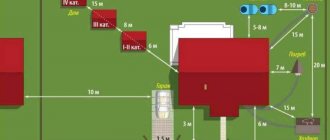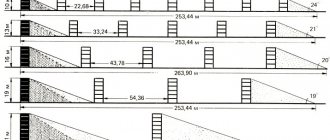Already at the planning stage, it is necessary to take into account all the details of future communications, including fencing the site.
The distance from the house to the neighbor’s fence is specified in a number of regulations, for example, SNiP 2017. For what purpose is it necessary to adhere to indentations? At a minimum, in order to comply with sanitary and fire safety standards.
The minimum distance between buildings must be maintained before construction begins. Otherwise, if conflict situations arise, the violator will be required to dismantle the buildings and may also be subject to administrative punishment. Following the rules, the construction of fences must also comply with certain standards.
Standards for setbacks from site boundaries
Before you start building a house, study the requirements of urban planning legislation, including regarding compliance with distances between buildings. Despite the fact that every owner of a plot wants to build a building that is convenient for himself, it is necessary to respect the rights and interests of the owners of adjacent territories.
At the legislative level, the following minimum standards for the placement of buildings have been developed:
- 5 meters - from a residential building or administrative building to the line of a pedestrian or roadway;
- 3 meters – from residential buildings to the access area;
- 3 meters – from a residential building to the fence of a neighboring plot;
- 6 meters – from window openings to neighboring buildings;
- 1 meter – from bathhouses, garages and sheds to the boundaries of the adjacent plot;
- 4 meters – from the places where animals are kept to the fences of the neighboring territory;
- 4 meters – from a perennial tree to the borders of an adjacent plot;
- 2 meters – from a low-growing tree to the neighboring territory.
Rules for planning plots and placing private houses with utility rooms
Legislative acts
When figuring out the norms for developing land plots for individual use, it is worth studying the legislative framework. Local authorities regulate the rules for placing a house on a SNiP site and establish requirements for the development of a land plot of individual housing construction. They determine construction standards in a particular region. Therefore, when looking at house designs and options for their placement, it is better to focus on options typical for the region .
The rules for the construction of a private house are established by SNiPs and GOSTs for construction. When creating a project, when building a house, you must be guided by SNiP 02/31/2001. For the construction of cottages in the country, it is worth following SNiP 02/30/97.
Individual housing construction must be carried out taking into account the provisions prescribed in the Town Planning Code. It is necessary to comply with established urban planning standards and requirements in terms of preserving the intended purpose of the land, norms for the development of populated areas, and compliance with the architectural plan of the city.
Why do we need indentations from the boundaries of the land plot?
Violation of the minimum permissible distance between houses is fraught with the following circumstances:
- the close proximity of window openings causes discomfort among residents;
- risk of fires due to the close proximity of buildings;
- the threat of sewage flooding the premises of a neighboring house;
- houses located in close proximity create shadows, which prevents the favorable cultivation of plants and creates a lack of sunlight in the living space;
- If neighboring buildings are too close, the placement of fences becomes problematic, because while one neighbor maintains a convenient distance, the other loses this opportunity and will be forced to install a fence against the wall of the house, which is extremely inconvenient for comfortable movement around the site.
Is it possible to build houses on the boundary
It must be said right away that the desire to build a house is not enough to do it well and correctly. For construction, it is important not only to decide what kind of house you want to build: choose the size of the house, the layout, but it is also important to plan where on the site the house will be located. And here the question arises not only of your comfort and the beauty of your site, but also the question of acceptable standards, which are determined by building regulations, as well as the convenience of your neighbors.
During construction, a number of typical mistakes are often made. One of them is when the building is located close to the fence. This is due to the fact that details are not taken into account: for example, the length of the stairs at the entrance.
To avoid this, before laying the foundation, you need to carefully measure everything. This applies, among other things, to the distance to the fence bordering the neighbors’ plots. This distance should not be less than three meters. At first glance, this seems like a lot; such an illusion can persist if a fence has not yet been erected between the areas bordering each other. After installing the fence, a fairly narrow passage remains, and if you also take into account that the meter will be taken over by the blind area, then there is no room left even to plant some kind of shrubs.
Important!!! Remember, the distance from the building to the boundary is calculated by the protruding parts of the building, which include the veranda, porch, etc.
How might the situation threaten you if a neighbor built a house close to the fence?
- If he did this earlier than you, and your house has not yet been built, it is important to know that there is such a thing as a fire distance that should be between houses . And you will have to take on this entire distance, that is, along the side border you will have to retreat 6 meters between the stone houses, if the houses are different: stone and wooden - 10 meters, if both houses are made of wood - 15 meters.
- Your neighbor's windows may be in close proximity to your windows, which will create discomfort for the residents of your home.
- All the rain runoff may end up on your property.
- Part of your plot will be in the shade, which will lead to worse conditions for growing plants and ultimately negatively affect the harvest.
- Building on a boundary line may result in a neighbor wanting to put up a fence, which will end up on your land and part of your land will join the neighbor's property.
Important!!! Construction of a house on the boundary of one of the neighbors is possible if the second neighbor has given his written permission to do so.
Is it possible to build close to the fence?
Construction of an object on the boundary line can be carried out if the owner of the adjacent plot has given permission for such development. It is advisable to obtain the neighbor's approval for development in violation of the minimum permissible boundaries in writing, in order to avoid any further disagreements on this matter in the event that the neighbor changes his decision.
Thus, you will insure yourself against possible legal proceedings initiated based on a neighbor’s complaint.
If a court decision is made in favor of the owner of an adjacent plot, whose rights are infringed by a building located too close, you will have to demolish part of the building in order to comply with the minimum permissible setback zone from the boundaries of neighboring territories.
Disputes between neighbors regarding indentations from the boundaries of a land plot
Construction of a residential building is a long and labor-intensive procedure. Therefore, if you see that already at the initial stage of construction the setback from your site required by the standards is not observed, you need to act immediately. Since at the beginning the construction process, carried out in violation of urban planning regulations, is much easier to suspend than when the building has already been erected.
If the building is close to the fence and you did not give permission for this action, find out whether permission has been obtained from the co-owner of your house (if any). If the second owner of the house gave consent (oral or written) to the citizen who started the construction of an object very close to your site, then this fact can be declared illegal in court. As proof of confirmation of your rights, present to the court a document on ownership of a residential building (part of a residential building), a cadastral passport and a land survey plan.
If the above documents are missing, then proving your case will be problematic. When asserting their rights, the main document that an infringed owner of a plot of land can refer to is the land demarcation plan. Standards for mandatory indentation must be observed from the extreme point of the territory's boundaries.
If land surveying has not been carried out, it is necessary to initiate this procedure urgently, otherwise it will be more and more difficult to prevent the construction of an object near your site every day. While no official delimitation of the land has been carried out on your part, an unscrupulous neighbor may rush in and get a land survey plan for his plot, thereby infringing on your interests. In this case, it will be almost impossible to prove your case.
If the documents confirming your rights to the land plot are available in full (property document, cadastral passport, land survey plan), then try to negotiate with your neighbor peacefully.
In most cases, having seen documentary evidence of your position, the neighbor will not want to start a legal battle in which he will be the losing party and will move his building from your site to a setback in accordance with the regulations.
If there is no response from the owner of the neighboring house and the construction of a facility continues, the location of which violates your boundaries, immediately seek protection from the judicial authorities. In such circumstances, the court conducts a special examination to determine compliance with the requirements of urban planning and sanitary standards.
In case of a positive verdict, the court will decide to demolish the building, the location of which violates the legal boundaries of the neighboring site.
Judicial practice on boundary disputes regarding the boundaries of land plots.
What to do when imposing boundaries of land plots, read here.
Read about the practice of forced seizure of land in court at the following link:
Sanitary rules
When calculating the distance between the fence and buildings, it is equally important to remember sanitary and hygienic standards.
For example, if a building is classified as fire hazardous, it should be located at least five meters from the fence. And the neighbors’ residential building is eight meters away. For example, to create conditions for reducing the distance to the external fence from a bathhouse or sauna, it is recommended to install a sewer drain that will provide drainage from this building. This is also important for others, which generate wastewater when using them. An outdoor toilet cannot be placed closer than twelve meters from the neighbors’ house and at the same time closer than twenty meters from the well.
All outbuildings must be equipped with a separate entrance, and when calculating the distance, measurements must begin from the protruding elements - canopy, porch, etc. The fence itself can have a very bulky design, which should also be taken into account.
It is strictly forbidden to seize part of someone else's land plot. It is allowed to cover only five centimeters of the total thickness of the fence being erected. Any other seizure will most likely be viewed negatively by the owners of the neighboring territory and the case may go to court. In addition, problems will arise with inheritance and alienation of real estate.
Where to contact if a neighbor has not retreated 1 meter from the property line
If during the construction of a neighboring house the setback standards established by law are not met, then contact the district administration to protect your rights. Based on your application, a commission must come to you, which includes land management specialists.
Based on the data from checking compliance with urban planning and sanitary legislation, the municipality will make a decision on the future fate of the building erected in violation of the established rules.
If, with the help of administration employees, it was not possible to solve the problem of violation of the boundaries of the site, contact the court with an appropriate petition. Document the fact of unauthorized placement of someone else's building in the immediate vicinity of your site.
The most preferable option is to organize a special geodetic examination, which will confirm the presence of violations with an official act.
Also organize inspections by fire and architectural supervision, which in turn will confirm the presence of violations of fire safety standards (if buildings are located dangerously close to each other, there is a risk of two objects catching fire at once) and building regulations. Having this evidence base in hand, you will not have to prove anything else; the court will make a decision based on the conclusions of the competent authorities.
In addition, recording facts of violations of indentation standards will allow you to bring your neighbor to administrative responsibility. If the non-compliance with the norms of the current legislation is critical (mold has formed on a residential building as a result of the lack of sunlight, the risk of simultaneous fire of neighboring buildings, etc.), the court will decide to demolish the “problem” building.
What laws govern the construction of fences?
The development process is standardized by the Russian Federation Code on Urban Planning, and SNiPs have been created for clarification. They often have additions approved at the local government level. This clarifies height standards and other recommendations for structures installed in a specific location.
Before starting work, it is worth looking into SNiP, because it stipulates the distance from the fence to each building. It is based on the rules of organizations that adjust the permitted distance to the fence from buildings. Amendments are sometimes made to SNiPs. Study the version that dates from the current year, you will know exactly how to build a fence correctly.
How to sue if a neighbor has not retreated 1 meter from the property line
In order to assert your rights in court, prepare a statement of claim with the following content:
- name of the judicial authority;
- Full name and contact information of the applicant;
- contact details of the offender;
- location of the land plot;
- the reasons for filing the claim;
- list of documents constituting the evidence base.
When drawing up a statement of claim, consider the following circumstances:
- your rights to the land plot must be legalized (availability of documents confirming ownership);
- a plot of land must be isolated on the basis of data from a geodetic organization (availability of a land survey plan);
- the fact of violation of the law by the neighbor in terms of non-compliance with indentations is documented (there are conclusions of the competent authorities);
- lack of agreement between you and your neighbor on the possibility of reducing the maximum permissible values for the distances between objects.
Distance from the fence to the house, to buildings, to the neighbor’s fence: norms
If the owner of the building thinks intelligently, then sooner or later a conclusion appears, which is limited to a list of prohibitive documentation. The best option would be to move the cottage to the side of the territory, away from the neighbor. In this case, the ingenuity of the inventor is more than justified, since in such a situation it is allowed to build fences directly next to a residential building. Therefore, the distance between the above objects is at least one meter. The presented standard is formed from the interests of home owners. When carrying out a full-scale renovation, the construction team will have enough space.
Statement of claim to eliminate violation of owner's rights
In the statement of claim, reflect information about the parties to the dispute (full name, residential address), the location of adjacent land plots and the essence of the conflict situation. Place the main emphasis in your application on the evidence base (which authorities were contacted, the results of inspections, etc.).
Attach all conclusions of the authorities that conducted the survey of the location of buildings in the originals.
Draw up the statement of claim in two copies, one of which is sent to the court, the other to the unscrupulous neighbor.
Judicial practice in disputes when a neighbor did not retreat 1 meter from the border of the neighboring property
The practice of litigation in this case is ambiguous. In most cases, the court makes decisions that make it possible to eliminate identified violations of setback standards without demolishing the building. This position is due to the fact that the demolition of the facility will entail disproportionately greater losses than the inconvenience associated with the construction of a building in unacceptable proximity.
For example, when a plaintiff argues that his property is flooded with rainwater from the roof of a neighboring house, the court makes a decision to install additional storm drains.
Installing a garage in violation of the meter zone from someone else’s house will also not serve as a reason for demolishing the controversial building. In such circumstances, the court rejects the claim due to its insignificance.
The standard justification of the judicial authorities in this case is the presence of the advisory nature of building codes and regulations regarding compliance with the setback from the boundaries of the site. In addition, the court refers to the provision of SNiP 2.07.01-89*, which states that by mutual agreement of the parties, the size of the indentation can be set different from the parameters specified in the standards.
Thus, achieving the demolition of a building due to its location being too close to your site is quite problematic.
Until it came to ruins
Some distances in photo format.
Military action is not a way out of the situation. Often, as practice shows, litigation does not lead to anything good other than replenishing the state treasury with your or your neighbors’ money. Decisions must be made before open hostilities.
Compromises are more acceptable and justifiable. But you have to be ready for anything. Our instructions cover three points:
- Standards for the placement of main buildings, planting of trees and shrubs relative to the boundary;
- Options for fencing the site;
- Resolving controversial issues.
What, where, for how long
Eh, border. You are the border.
We will consider the problem of placing various objects on a site in accordance with building codes and regulations using the example of a garden plot. As practice shows, it is in this direction that most clashes and misunderstandings occur.
So, let's turn to lawmaking:
Note! Before starting a very useful excursion through the legal jungle, we invite you to pay attention to the fact that these standards presuppose a legally fixed boundary of the plots, otherwise you will face long and fruitless ordeals along the corridors of the relevant authorities.
- We will not focus your attention on the size of the plot; firstly, they may be different, and secondly, the rules listed below apply to any areas;
- It is recommended to fence individual areas, and the fence should be either mesh or lattice 1.5 meters . The rules also say that it is permissible to erect a solid, closed fence on the side of the roadway or street;
For your information! Although we will consider the issue of division separately, I would like to immediately note that the issue of fencing the site from neighbors is advisory in nature. And to the question of how to force a neighbor to put up a fence, we will answer that if he did not demolish it, then there is no way.
In this matter, the main weapons are documents and tape measure.
- In addition, the same rules allow the placement of a cesspool on your site, and in the absence of a centralized sewer system - a latrine;
- The construction of residential buildings, garages, sheds, baths (saunas), showers, carports is permitted if appropriate projects are available. In addition, the distances between buildings within the same area are not specified;
- And now attention, the most interesting thing is why all the misunderstandings arise. The house or cottage must be located at least 5 meters from the red line of the street, and 3 meters from the red line of the driveways;
Our help! The red line is an architectural concept that has taken root in cadastral realities. This line means the conventional boundary between the roadway of the street and the building area.
- And now about what provokes neighbor wars - about the minimum distance to the border of the neighboring land:
- The distance from the house to the neighbor’s fence must be at least 3 meters;
- There should be at least 4 meters from sheds where small animals are kept and poultry houses;
- The distance from sheds for other purposes, garages, sheds must be at least 1 meter;
- There should be no less than 4 meters from the trunks of tall trees to the border, no less than 2 meters from medium-sized trees and no less than 1 meter from bushes.
- As the heroine of the film “Office Romance” said, “all in yourself.” At the same time, there is one more tightening that must be voiced. If a roof slope, a wall fragment, a porch, a canopy adjacent to the house, and other small and not medium-sized architectural forms protrude from the general ensemble of the building by more than half a meter, then this distance is calculated from them;
- And that is not all. Even when moving 1 meter away from the boundary, and erecting the slope of the roof of the barn, you must direct it in your direction;
- There are quite strict standards regarding the distances from the cesspool to other buildings:
- So the distance from a residential building to a cesspool should be no less than 12 m;
- From showers, baths and saunas - at least 8 meters;
- It is allowed to dig wells at the same distance.
Note! These distances are equally applicable to buildings in the adjacent area.
The bill will start from the veranda.
- And to fully flesh out this topic, we will consider more options for joint buildings. It is very fashionable to combine buildings, for example, a house with a garage, or a house with a poultry house or a winter garden; this is allowed by the standards, but in this case the permissible distance is calculated separately for each object. And if a neighbor built a house close to the fence, thereby violating established standards, you have the right to demand compensation.
Fences are not only an element of fencing, but also a solution to legal disputes
Who is man to man?
It’s good if you are lucky and you decide to build a common fence with your neighbors and divide the costs equally, many may envy you. Although, by and large, this is normal practice for resolving neighborly disputes. Usually the plot goes to the owner with boundary signs. In normal circumstances, having notified your neighbors, you can begin building the fence.
Why is the issue being discussed with neighbors?
- The fact is that any cross-border work must be done together, this will initially smooth out those sharp corners that may arise later;
- According to the rules of land use and development, administrative liability may arise for intrusion into someone else's territory (including for violating the distance from the fence to the building according to SNiP). And these are fines and forced dismantling of the erected fence, which, I must say, is not a cheap pleasure. Therefore, if a neighbor has put a fence on my territory, you can gently hint to him that he is wrong. Tell him about the rules of land use and development. But if a neighbor put a fence on my property, found out that he was wrong and did not react, then let him blame himself; the state treasury will be replenished at his expense.
In this case, the fence can be:
- Temporary;
- Permanent.
- About temporary fences. There are situations when the site where construction is planned is best taken under protection. This is the moment when building materials have already been delivered, but construction has not yet begun. In this case, a temporary fence will help you. The name speaks for itself - easy to install, easy to remove. You drive metal pins or pipes around the perimeter and install the chain-link mesh with your own hands, it couldn’t be easier. In case of disputes and disagreements, such a structure can always be easily dismantled and moved to a new location.
Temporary, it is temporary in Africa too.
- Permanent fences. Here everything is clear to you - the fence goes strictly along the boundary, is installed once and for a long period of time, the price of the capital product will be appropriate. Therefore, all legal issues must be resolved before installing a permanent structure.
There are general requirements for stationary fences:
- The fence must be installed permanently on reliable supports. It must withstand gusts of wind, rain and melt water, and its own weight;
- The fence should not shade buildings, as well as existing green spaces;
- The appearance of the product must be aesthetic on both sides;
- Solid fences are allowed on the street side, but not more than two meters high.
Such a fence can only be installed in a pure “legal field”.
Is it worth going to court if the neighbor has not retreated 1 meter from the property line?
If your rights and legitimate interests are violated, you have the right to go to court under any circumstances (no matter how insignificant the offense committed against you may seem).
However, the practice of considering legal disputes based on the application of persons who believe that their rights have been infringed due to non-compliance with a meter setback from their site during the construction of an object is disappointing. The decision to demolish a “problem” building is made only in exceptional cases when there is a threat to life and health (gross violations of fire safety standards).
In other cases, the courts take a loyal position towards violators. If it is possible to eliminate the identified violations without resorting to drastic measures, then the courts make decisions regarding the installation of storm drains, the relocation of the porch of the house, etc. When it is possible to eliminate violations of the rights of the owner of a neighboring plot only by demolishing the house or dismantling part of the building, the court denies the claims due to their insignificance.
Was the Recording helpful? No 1,472 of 1,767 readers found this post helpful.
Design nuances
In the case of summer cottages and cases where construction is carried out by the owner himself, and not by professionals, the distance to the neighboring territory is often simply missed, which leads to disputes.
Therefore, references to SNiP are simply extremely necessary, at least from this side. The exception is, again, a signed agreement between the owners of adjacent lands, which is usually achieved by paying monetary compensation. However, it is advisable to coordinate permits received from neighbors with the Bureau of Technical Inventory to be sure that the law is not violated. Next, construction projects are agreed upon in a general manner. In the case when we are talking about legalizing existing buildings, such a procedure will have to be carried out exclusively through the court. At this stage, it sometimes makes sense to seek help or at least advice from a competent lawyer.
Only having in hand documents confirming the legality of real estate and its commissioning can you register ownership rights to it.








